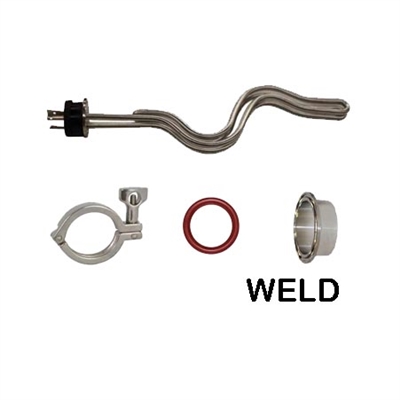
5500 Watt, TC integrated heating element with L6-30P locking male plug, TC clamp and gasket to install in the TC port welded in to the kettle. Note that we install the element TC port on the right side of the kettle (at the 3 o'clock position if the front of the kettle is 6 o'clock) We can install it at 12 or 9 o'clock by request.
 Pickup tube
Pickup tube- Edge style pickup tube, threaded into the welded drain bulkhead. This solution wraps the drain entrance completely back to the kettle wall. In the Spike kettles, it settles right on the slope of the shelf. Note that the base kit of this system does NOT include a ball valve on the outside of the drain port. If you select the Topsflo pump kit, the pump will thread in directly. If you get the Riptide pump kit, it does include a valve for this port. If you have your own pump setup already, keep in mind you'll need an extra valve and QD for this port.
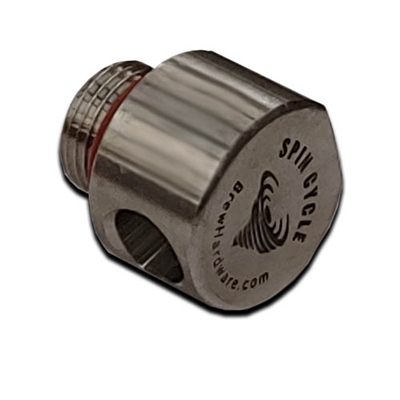 Whirlpool return
Whirlpool return, BrewHardware Spincycle shorty threaded into the kettle's welded whirlpool port. This unit can usually be freely rotated to select clockwise or counterclockwise stirring. We recommend a slightly upwards output angle to encourage vertical mixing during the chilling operation to reduce temperature stratification. Rotation direction has not proven to be important for successful trub cone formation post boil.
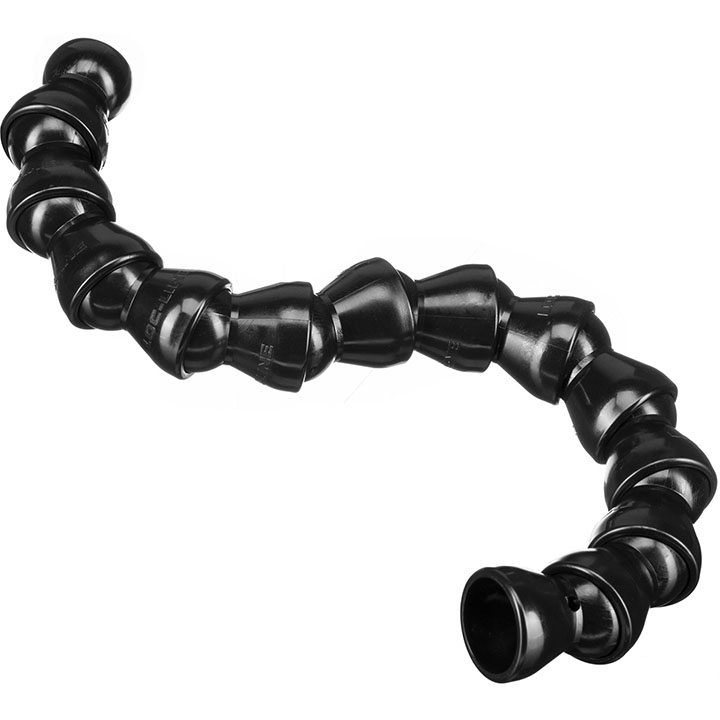 Locline Recirculation Kit Installed through the lid of the kettle. This solution is decidedly better than draping a silicone hose on the grain bed because it is articulating and holds its position exactly where you position it. You can orient the outflow exactly at the height of the top of the grain bed to reduce boring holes in the grainbed. It is also superior to lid mounted sprayers that cannot be height adjusted because spraying or dripping wort from several inches above the grainbed causes more heat loss and oxidizes the malt more than necessary.
Locline Recirculation Kit Installed through the lid of the kettle. This solution is decidedly better than draping a silicone hose on the grain bed because it is articulating and holds its position exactly where you position it. You can orient the outflow exactly at the height of the top of the grain bed to reduce boring holes in the grainbed. It is also superior to lid mounted sprayers that cannot be height adjusted because spraying or dripping wort from several inches above the grainbed causes more heat loss and oxidizes the malt more than necessary.
3-Way TEE with dual valves on the whirlpool port. This "manifold" is the main operator for the different modes of kettle operation so we'll explain this in some detail here. This combination of two valves selects whether recirculated wort goes into the whirlpool port, goes up and over the grain bed or both. The individual valves for each wort path also allow you to customize the flow rate to each destination. Whirlpool is used during initial water heat up as well as during immersion chilling. In the "both" position with both valves open to some degree, wort is recirculated over the grain to distribute new heat input as well as whirlpooled to keep the lower layer fully mixed and at the same temperature during the mashing phase. This recirculate and stir combination feature is not found on any competitor systems and is the real key to perfect temperature. This cannot be emphasized enough. Many users of recirculating BIAB systems complain about temperature stability issues along with pumping too quickly over the top and possibly dry firing their element. This dual flow path system is the solution to both problems. Finally, the recirculate only mode is great for filling your fermenter. Instead of this hose going up to the lid mounted locline port, it gets quick disconnected from the lid and dropped into or connected to your fermenter. The input and recirculation output to the tee system is equipped with BLQD-F (male QD) on the input side and a mini ball valve and additional BLQD-F on the recirculation output side. The mini ball valve is used to throttle the recirculation to tailor the mix between stirring and recirculation. We recommend limiting the recirculation flow rate to 2 quarts per minute or less to avoid dry firing the element.
Everything listed above represents the common "base" kit that all share the same components regardless of which pump add on you select. The price listed is for the base build by kettle size. The cost of the pump kit add on is the same regardless of which kettle size you select.
CHOICES YOU HAVE TO MAKE OUTSIDE OF ORDERING THE BASE KIT ABOVE
Pump Choice (You will add one of the two pump kits as a separate cart item)
- For $160 The Topsflo TD5 24 Volts DC brewing pump kit option is recommended on the 10, 15 and 20g kettles.. This is shown in the main picture of this item. When you select the Topsflo TD5 pump kit, you will thread the pump directly into the drain port of the kettle. The pump output gets a high flow elbow barb, a length of silicone tubing and a set of BLQD quick disconnects to couple into the 3 way valve on the whirlpool.. CLICK HERE TO ADD THE TOPFLO KIT OPTION TO THE CART
- For $330 The Blichmann Riptide Pump kit option is a larger, bulkier, louder and more powerful pump and is recommend for the 30 gallon size. It would also be a slight whirlpooling performance upgrade for the 20g size (and would double as a spray ball CIP pump for your conicals regardless of kettle size) if it is within your budget. When you select the Riptide pump kit, we include a 3pc ball valve on the kettle drain and all the male/female quick disconnects to make two hose assemblies. One hose goes from the drain to the pump and another from the pump up to to 3way valve. The added cost of of the extra hardware is built in to the pump choice selection and is not just the price difference between the pumps alone. CLICK HERE TO ADD THE RIPTIDE KIT OPTION TO THE CART
Temperature Controller (You will add as a separate cart item if you do not already have a controller)
We stock two controllers for your consideration;
The Blichmann Brew Commander and the
Auber Cube 5e. The Brew Commander has been sporadically available so if you're unable to add it to the cart, it's because they are fully unavailable. The Cube is always available. You can read about each of the controllers on their respective product pages linked above but we've also created a
buyer's guide to help compare the features.
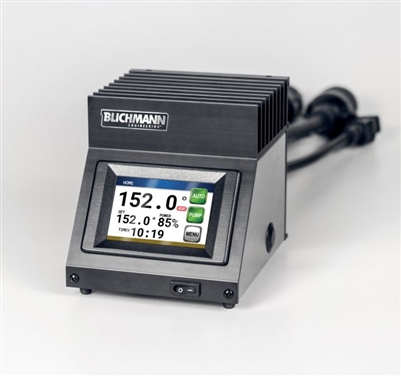
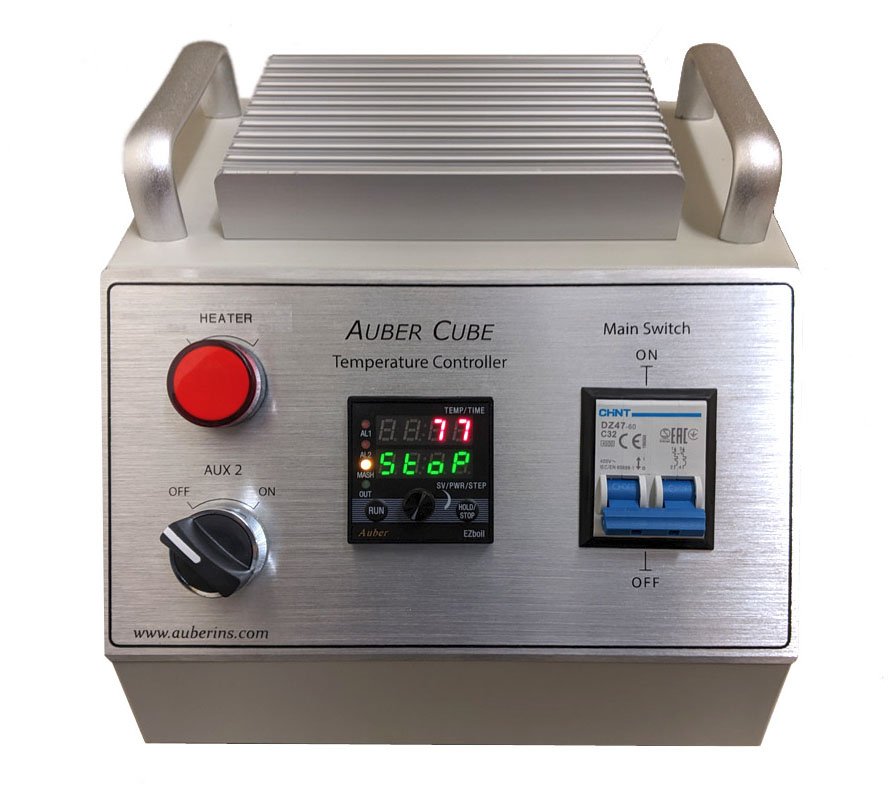
Be sure to visit the respective product pages to add one of the controller's to your cart.
*Not Included*
Pump: As stated above, a pump upgrade kit is optional. The picture of the system shows the topsflo pump installed. If you already have a pump and some hoses/QDs, get in touch with us to be sure you have everything you need when skipping a pump add on kit.Drain Ball Valve and QD : This is included in the Riptide pump add on kit and not required with the Topsflo kit.
Steam Control
If this is your first venture into electric powered brewing, you're probably psyched about the prospect of brewing indoors, maybe in a garage or a dedicated brew room in your basement. Don't be caught off guard by the amount of steam that builds up in enclosed places when you boil for an hour or more. If you set up near a window, you can do a reasonable job of venting with a small fan blowing out. If you want to keep the brew day as silent as possible and keep your heated/air conditioned air inside, read all about the the
Steam Slayer product on its dedicated product page. If you think you may want to implement the Steam Slayer into your kettle, even if it's in the future, it would be most economical to have us install the appropriate TC port into the kettle while we're already building the system for you for about $50. You can cap it off in the meantime.
In order to make ordering easier, you can
make this system "STEAM SLAYER READY" by CLICKING HERE.
This will add all the parts and labor to the cart to weld a TC port in which can receive the Steam Slayer. If you plan to use it immediately don't forget to add the Steam Slayer kit to the cart as well.
ChillerWe do not include a standard chiller because the "best" type of chiller is so highly debated.
With the endless system options out there, what sets this one apart? That is a completely reasonable question and we're going to spend a good portion of time explaining why the whole staff chose this configuration and why some of the more popular systems fall short (for us).You can use this information to make an informed decision for your own system. There are a few different aspects to compare and contrast so we'll break it down by topic rather than brand specifics.
Bag vs Basket
We chose a food grade mesh bag for our system, in contrast to systems that use a rigid stainless steel basket (sometimes called a malt pipe). For one thing, it reduces the overall system cost. There are some low cost systems that use a rigid basket but they are flimsy and generally only drain at the bottom. The premium basket systems have a substantial price increase and is frankly no easier to use than a bag. The flexible bags tend to drain wort more completely due to the teardrop shape that forms due to the grain weight. It also allows for more wort extraction with a gentle squeeze with a gloved set of hands.
The last, and perhaps the most important thing to consider with basket designs is if they allow an undesirable amount of grain particles to pass through and into the boil kettle. Unfortunately some designs use the same hole/slot pattern on baskets that you would regularly find on a mash tun false bottom. False bottoms could get away with letting grain through since a recirculation in a dedicated mash tun would clean that up and allow clear wort into the boiler. In a BIAB system, any grain that gets through is now in your boil for good.
But doesn't the basket keep the grain off the heating element? Yes, but we've custom designed a coarse mesh false bottom to keep the bag from touching the element and to form an adequate liquid-only area to receive and disperse heat from the element.
Contrasted to All In One "URN" style systems
Proprietary vs modularity: One of the biggest downsides to the full system, small foot print coffee urn style systems is the proprietary nature of all the components. The heating element has to be sourced from the manufacturer if it burns out. If that model or brand is discontinued and the parts market dries up, you will have to discard the entire system. A similar issue exists with some systems that have built in temperature controllers and recirculating pumps.
On the other hand, we use standard modular components that have existed in the market for long enough to ensure long life, serviceability and if all else fails, a suitable open market substitute can be purchased at any time. For example, install industry widely accepted heating elements using the Triclamp standard. You are never stuck buying elements from any one vendor. The same can be said for the pump and whatever controller you use.
Power/Time Investment: Most all in ones are painfully under powered. While they get the job done eventually, the ramp times for heat water initially as well as ramping the wort up to a boil are quite long. Even the systems that offer 240 volt input options still use lower wattage elements than we prefer. We put a hefty 5500 watt element in our systems. For comparison's sake we can take 6 gallons of strike water up to 160F in 15 minutes while the same would take 55 minutes on a 1600 watt URN system. That's a 40 minute difference just for the water heat up step. In almost all cases, you're never waiting for something to heat up with this system. It's usually hot already and waiting for you.
Batch Size Scaling and Future Upgrades
This is a similar contrast as the topic of modularity, but specific to batch sizes. When you buy an URN system, you are buying something cable of typically one batch size and that's it. There is no upgrade path without buying a whole new system. On a modular system like ours, the only thing you need to change to upgrade your maximum batch size is the kettle, false bottom and bag.You'll use the same heating element, pump, controller and accessories. The kettle is the cheapest part of the whole system.
What is Brew In A Bag? This all grain brewing method is purported to have been born in Australia based on minimalist pragmatism. The rest of the world started catching on and most of the big manufacturers have finally released their versions of this simple type of system.
This process involves mashing your grains directly in your slightly oversized boil kettle. Grain is contained within a large, fine mesh food grade bag and the spent grain is removed from the wort by pulling the bag out. The concept of sparging (rinsing extra sugars off the grain) is not impossible with this process, but the vast majority of BIAB brewers run a full volume, no sparge mash which means the removal of the grain leaves the desired pre-boil volume. The method makes perfectly good, award winning beers and the brew day is simple and the gear is easy to clean up.
NOTE: These systems are not offered with free shipping as the box size and total weight costs a lot to ship and we didn't want to make it unfair for local and nearby customers to try wrapping the average shipping cost into the package. The compromise we did make was to rate the shipping weight much lower than actual so you'll pay a little less than half the shipping cost and we pay the rest.


 Awesome System - Unbeatable Value
Awesome System - Unbeatable Value 


